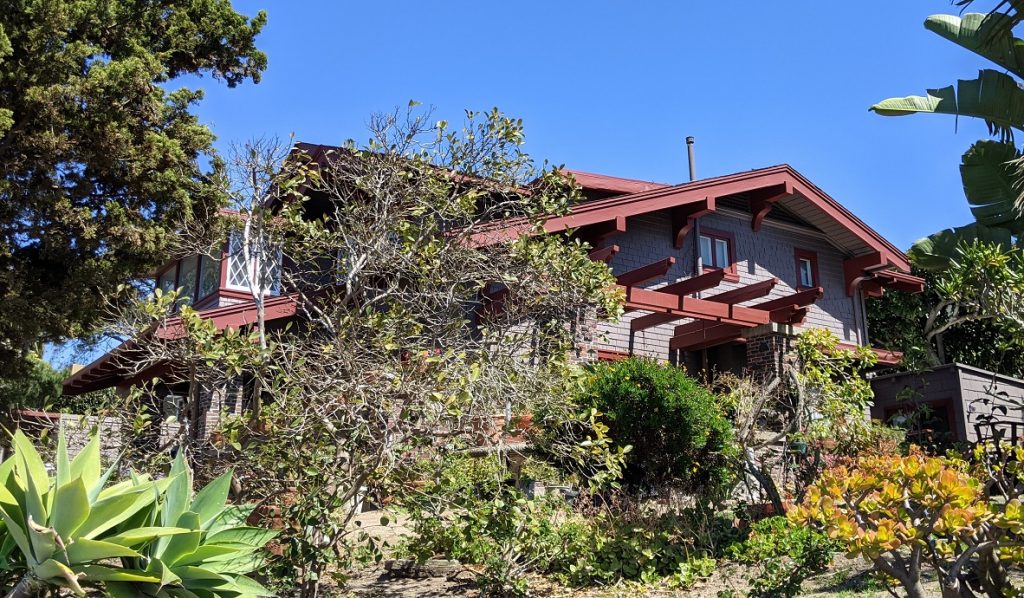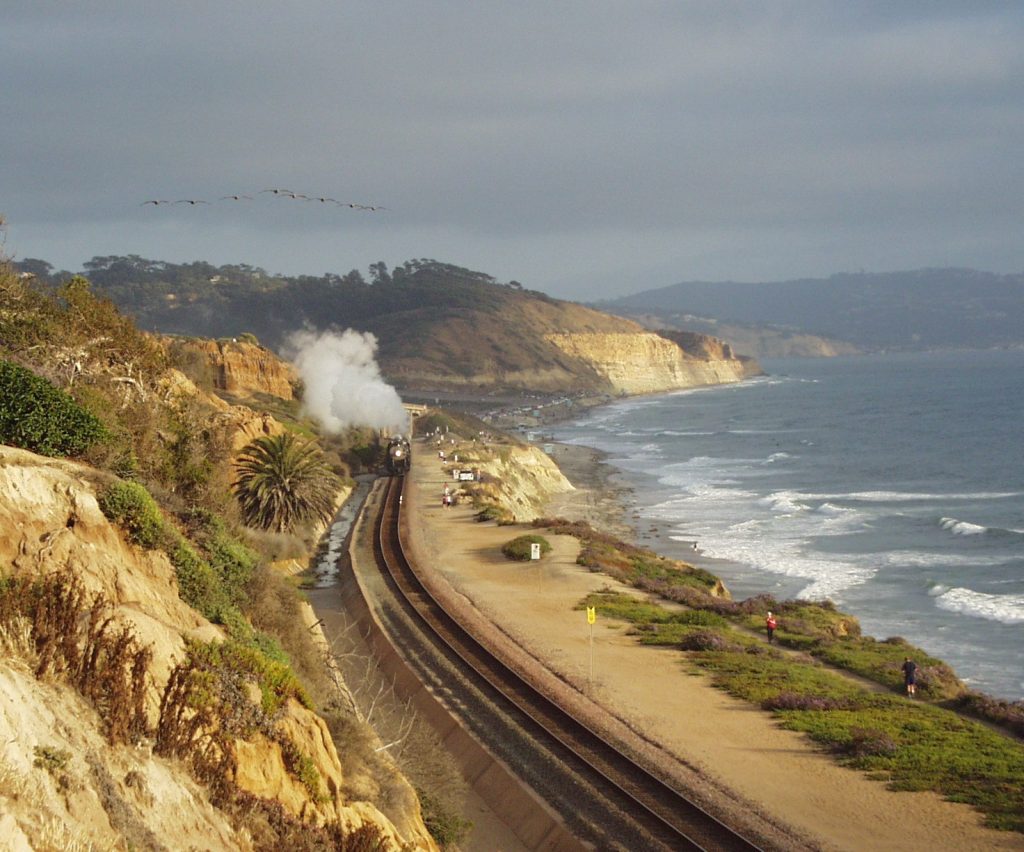A recurring news story in recent years has been yet another bluff collapse where the railroad line passes above the beach in Del Mar. At the end of February 2021 it was a section of bluff just south of 4th Street that gave way. No-one was injured in this incident but as a precautionary measure trains have been required to pass through the area at reduced speeds. In November 2019 heavy rains and stormwater runoff caused a bluff collapse south of Seagrove Park that came within a few feet of the tracks. Trains continued to run under restricted speed limits then too but for months the line was shut down on weekends to allow construction crews to shore up the bluff with steel plates and a reinforced concrete wall. Before that, between August 2018 and February 2019, six bluff collapses had occurred in a two-mile section of the Del Mar bluffs causing short-term interruptions of passenger service on the railroad. After each of these incidents it was noted that the bluffs are eroding at an average rate of 6 inches annually and that San Diego’s only active railway connection to the outside will eventually have to be moved inland, away from the top of the bluffs, a move that will cost an estimated three billion dollars and require decades to complete. The potential alternative routes will all require tunnels or a deep trench under Del Mar and after the latest incident the San Diego Union-Tribune reported that a drilling rig was on the streets taking soil samples from 200 feet below.

Ironically, this section of the railroad line has already been moved once before – from a safe inland route over the streets of Del Mar to the now precarious location on the ocean bluffs. In 1881 the California Southern Railroad began laying tracks north from a terminus on San Diego Bay to connect with the Atlantic and Pacific Railroad, a transcontinental railroad then being built across northern Arizona. The California Southern line ran north through Rose Canyon and over the Miramar divide to Sorrento Valley, where it crossed the eastern edge of Los Penasquitos Lagoon on a causeway then climbed the ridge north of the lagoon toward Del Mar (portions of this right of way can still be seen south of Ocean View Avenue). It passed through Del Mar on Railroad Avenue, today’s Stratford Court, where a depot was located at about 9th Street. From the north end of Railroad Avenue the line descended towards a crossing of the San Dieguito River and continued along the coast to Oceanside.

Beyond Oceanside the route originally went inland along the Santa Margarita River to Temecula and Colton, then through Cajon Pass to Barstow and a connection with the A & P. That line was abandoned after several washouts in the Santa Margarita valley and rail traffic from San Diego was switched to the ‘surf line’, the route between Oceanside and Los Angeles still in use today. The surf line was later incorporated into the Santa Fe Railroad and since 1992 the portion in San Diego County has been owned by the North County Transit District, which operates Coaster commuter trains between San Diego and Oceanside.

The California Southern was still running over the streets of Del Mar in 1905 when the South Coast Land Company acquired much of the property in the community and in other coastal communities as far north as Oceanside and embarked on an ambitious program to develop the area. This company was headed by four wealthy businessmen from Los Angeles, Henry Huntington, William Kerckhoff, Henry Keller and Charles Canfield, and also Ed Fletcher, a San Diego real estate promoter. Huntington had consolidated regional rail lines in and around Los Angeles into the Pacific Electric interurban rail system in 1901 and since then had been expanding it into cities and towns surrounding Los Angeles. Huntington and Kerckhoff jointly owned of the Pacific Light and Power Company, which provided electric power in the Los Angeles area, including to the Pacific Electric. Keller and Canfield were financiers, having made fortunes in land (Keller had sold the Malibu ranch in 1892) and oil (Canfield and Edward Doheny drilled LA’s first ‘gusher’ in 1892). Fletcher was a land agent with extensive knowledge of San Diego’s rural back country.

The development plan was modeled on previous ventures in which many of the same businessmen had bought up tracts of land in undeveloped areas, extended the electric railroad and utilities they controlled into these areas and profited by selling building lots and water and power to the thousands of new residents they attracted. In San Diego County water and power were to be provided by a huge new power station on the San Luis Rey River for which Fletcher would arrange the purchase of dam sites and water rights. Fletcher also mapped out the building lots in new subdivisions, beginning with Del Mar. For rail service, the plan was to build an electric line between Del Mar and San Diego that would eventually connect with Huntington’s Pacific Electric in Santa Ana.
In January 1907 Keller and Kerckhoff obtained a franchise to build and operate a railroad within the city of San Diego. San Diego’s city limits extend north as far as the Del Mar bluffs and the Keller-Kerckhoff railroad was intended to follow a route across the western side of Los Penasquitos lagoon toward these bluffs. In Del Mar the route would continue along the bluffs to where they end at about 15th Street, where a new station would be built close to the hotel the land company intended to build. Construction began at the San Diego end in mid-December 1907 and by May 1908 grading of a roadbed was underway north of the San Diego River. Fletcher proceeded to map and acquire property for the remainder of the right of way to Del Mar, which was initially expected to include a tunnel under Mount Soledad.

However, while an expansion of the Pacific Electric to San Diego may have appealed to Henry Huntington and the South Coast Land Company the prospect of new competition was not welcomed by the existing steam railroads and although Huntington was a founder and president he did not own a controlling interest in Pacific Electric. E. H. Harriman, president of the Southern Pacific railroad, also held a large position in Pacific Electric and made it known that he would oppose extending it to San Diego. With its future link to Pacific Electric effectively blocked by Harriman, interest in the Keller-Kerckhoff railroad to Del Mar faded and construction work was discontinued. It was never completed, and the power station on the San Luis Rey River was also never built, but the land company did succeed in developing Del Mar into a resort community. The company’s principals were among the first to acquire building lots and many built summer homes there.
The Keller-Kerckhoff railroad never arrived but its right of way in and around Del Mar offered lower elevations, more favorable grades and fewer curves than the original California Southern route followed by the Santa Fe. In 1909 the right of way was acquired by the Santa Fe and two steam shovels and a force of about 300 men were employed to grade a roadbed and lay tracks. The new route along the blufftop and on an embankment that sloped up from the lagoon to the southern end of the bluffs replaced the old route’s steep climb into Del Mar. When the first train passed over the completed line in August 1910 the Union reported that hundreds of citizens lined the tracks along the bluff for nearly two miles waving enthusiastically. The Santa Fe had built 8 ¼ miles of railroad, reducing the grade from 2.2 to 1.4 percent but adding only 87 feet to the actual distance. Three of the worst grade crossings on the line had also been eliminated.

Del Mar historian Nancy Hanks Ewing also credits the South Coast Land Company for the building that served as the Del Mar station from 1910 to 1995. She wrote that W. G. Kerckhoff disliked the ornate two-story frame structures then in use by railroads and when designing a new depot on the proposed route of the new electric railroad he patterned it after Pacific Electric stations in the Los Angeles area – long, low, and of red brick. The Santa Fe completed the red brick station building to serve Del Mar after their new blufftop line opened and the original route and station on Stratford Court were abandoned. It is still standing at the side of the tracks near the beach at Del Mar but trains no longer stop there, stopping instead at the transit center in Solana Beach a few miles up the line.
The challenges to the blufftop route around Del Mar were apparent from the very beginning. In 1910 the San Diego Union wrote that construction of the new cut-off was ‘apparently an impossible engineering feat’. A particularly difficult area was nicknamed Devil’s Canyon because of its ‘habit of spitting an immense volume of water out at the new work at the wrong time’. The engineers addressed that difficulty by building a retaining wall 80 feet in length and 16 feet high with a drainage culvert at its base and an earthen embankment above the wall where the rails were laid. However, heavy rains in December 1940 softened the roadbed on the embankment and a northbound freight train ran off the rails. The engine and a number of empty boxcars slid down the slope toward the beach, the engineer and fireman in the engine’s cab were scalded to death by the steam, and a brakeman was crushed to death between two cars. The Union noted that a northbound passenger train bearing holiday crowds had passed the spot safely twenty minutes earlier. There have been no more actual train wrecks on the Del Mar bluffs but the constant erosion and increasingly frequent collapses of the bluffs affirm that the blufftop railroad ultimately is an impossible engineering feat and the railroad through Del Mar will be moved once again.


